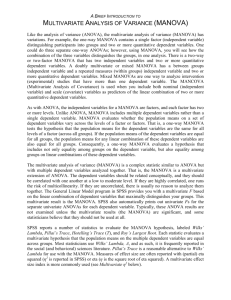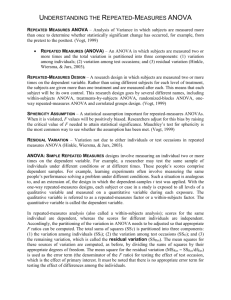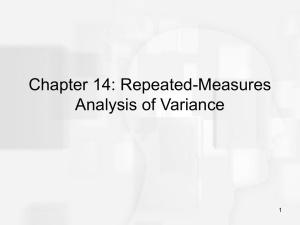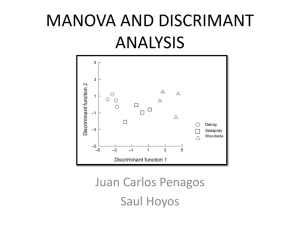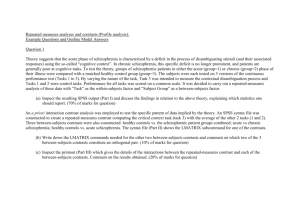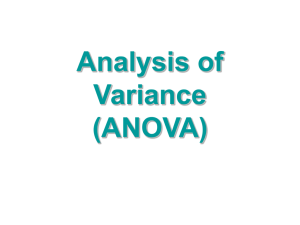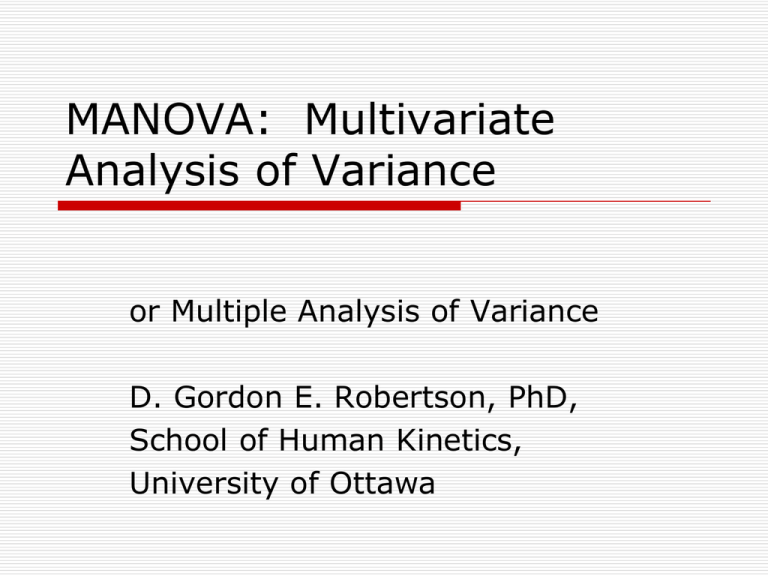
MANOVA: Multivariate
Analysis of Variance
or Multiple Analysis of Variance
D. Gordon E. Robertson, PhD,
School of Human Kinetics,
University of Ottawa
Review of ANOVA:
Univariate Analysis of Variance
• Simple ANOVAs are used to investigate
whether or not there is a difference in the
scores of a single dependent variable (DV)
that is due to membership in a group in
comparison to two or more groups. I.e., are
there significant differences between three or
more independent groups based on a single
independent variable.
• The independent variable (IV) is a nominal
quantity, the dependent variable should be an
ordinal or ratio/interval quantity.
Example:
Stair descent study
Cluff and Robertson (2011) Gait & Posture. 33:423-8.
Seventeen subjects (9 males, 8
females)
Descend a five-step stairway. Data
for last step (ground) were not
analyzed.
Three measures of peak power were
recorded, one at the ankle by the
plantar flexors, one by the knee
extensors, and one by the hip flexors
Design
Dependent variable(s):
A1 – peak ankle plantar flexor, negative power
K3 – peak knee extensor, negative power
H2 – peak hip flexor, positive power
Independent variables:
Steps (1 to 4)
Sex (M or F)
Designs:
One-way factorial
One-way repeated-measures
Two-way repeated-measures MANOVA (step, joint)
Three-way mixed MANOVA (add sex)
One-way Factorial ANOVA
This test will only look
at the ankle powers
(A1) as if different
people descended each
of the four steps.
Review of ANOVA
• Before examining the F-statistic, check that
the ANOVA meets the homogeneity of variance
test. SPSS uses Levene’s test.
Levene's Test of Equality of Error Variancesa
Dependent Variable:A1 power
F
df1
df2
Sig.
.819
3
64
.488
Tests the null hypothesis that the error variance of the dependent variable is equal across groups.
a. Design: + Step
• Since significance (i.e., 0.488) is greater than
a = 0.05, the null hypothesis is rejected so the
variances across groups are assumed to be
equal.
Basic ANOVA Output
Tests of Between-Subjects Effects
Dependent Variable:A1 power
Source
Type III
Sum of Squares
Cor. model
17.422
899.794
Step
17.422
Error
71.350
Total
988.566
Corrected Total
The IV,
“Step”
df
3
1
3
64
68
88.772
Mean
Square
5.807
899.794
5.807
1.115
F
Sig.
5.209
807.109
5.209
.003
.000
.003
Partial Eta
Squared
.196
.927
.196
67
A
B
C
Important information in the ANOVA output:
A. The F ratio
B. Significance of that F ratio
C. Partial eta squared (estimate of the “effect size”
attributable to between-group differences
D. Power to detect the effect (0.911 is very powerful)
D
Observed
Power
.911
1.000
.911
Post hoc test of ANOVA
•
•
•
Since there is a significant F we can do post hoc testing.
If not significant this step IS NOT DONE.
The ANOVA only shows “at least one” group was
different from the others. But which one?
Since we are going to test all possible pairs the Scheffé
test is recommended. It is
also the most conservative.
The results show that steps 1
and 2 are significantly different
from step 4 but step 3 is not
different from any of the other
steps.
One-way Repeated-measures
ANOVA
Now repeat the analysis with the same
data but recognizing that the same
people were used, i.e., it was a
repeated-measures design.
First, repeated-measures requires the
homogeneity of covariance's, i.e., the
variances of the differences between
groups are equal. This is called
“sphericity”.
Repeated-measures ANOVA
LSD is not
recommended, if
sphericity is OK use
Sidak, otherwise
use Bonferroni.
Repeated-measures ANOVA:
Test for sphericity
SPSS uses Mauchly’s Test of Sphericity.
Since the p-value (Sig. = 0.163) is greater than a = 0.05,
we reject the null hypothesis that covariances are unequal
and can “assume sphericity”.
Repeated-measures ANOVA:
Results
SPSS shows results for four different
assumptions. We can choose the first.
Since the p-value (Sig. = .000) is less than a = 0.05, the null
hypothesis is rejected and conclude there is a significant difference
across stair steps. Note, a p-value of 0.000 is written p<0.0005.
Repeated-measures ANOVA:
Test for best fit
SPSS shows results of fitting polynomials
from linear to degree k-1.
Since there are only 4 steps, SPSS only tests to a cubic (3rd degree)
fit. In this example a linear fit was best. Note, this statistic makes
no sense if the DV is not ordered, such as time, age, or date.
Repeated-measures ANOVA:
Plot of marginal means
SPSS can plot the group means. This
plot shows the means for each step.
Looks like a linear increase in A1 power as people descend
the stairs. Note, A1 is a negative power.
Repeated-measures ANOVA:
Post hoc tests
•
•
Since there is a significant F we can do post hoc testing.
If not significant this step IS NOT DONE.
We will use the Sidak post hoc test. Bonferroni is too
conservative. Choose from the Options… menu, NOT
the Post Hoc… menu!
The results now show that
steps 1 and 2 are not
significantly different for each
other but are different from 3
and 4 and steps 3 and 4 are
different from all the other
steps. This is a better result
than the factorial ANOVA.
MANOVA: Example:
Repeated-measures
The MANOVA or multivariate analysis of variance tests
the hypothesis that one or more independent variables,
or factors, have an effect on a set of two or more
dependent variables.
The present data must be organized as a repeatedmeasures ANOVA with three dependent variables, one for
ankle powers, one for knee powers, and one for hip
powers. The factor “stair” steps is also a repeatedmeasure since the same subjects descend each step.
This is now a repeated-measures MANOVA.
Assumptions for MANOVAs
1. The two or more dependent variables should be measured at the
interval or ratio level (i.e., they are continuous). I.e., A1, K3, H2.
2. Your independent variable should consist of two or more nominal
or categorical, independent groups.
3. You should have independence of observations, which means that
there is no relationship between the observations in each group or
between the groups themselves. For example, there must be different
participants in each group with no participant being in more than one
group. This is more of a study design issue than something you can test
for, but it is an important assumption of the one-way MANOVA.
4. There should be multivariate normality. However, in practice, it is not
uncommon to simply check that your dependent variables are
approximately normally distributed for each category of the
independent variable.
5. There needs to be homogeneity of variances (i.e., equality of
variances between the independent groups).
Each column is a repeated
measure. Each row is a subject.
MANOVA:
Multivariate tests
The interaction and both main effects are
significant, with p<0.0005.
MANOVA:
Test for sphericity
Main effects pass sphericity test but
interaction does not.
MANOVA:
Within-subjects tests
Main effects and
interaction are all
significant. Note, effect
sizes are relatively
large, and powers are
excellent.
MANOVA:
Best fit tests
MANOVA: Example
Mixed with repeated-measures
Add sex as a between-subjects
variable.
There is no significant difference
between sexes.
MANOVA:
Post hoc tests
Step 1 differs
from 4, step 2
differs from 3
and 4, step 3
from 2 and 4,
and step 4
differs from 1
and 2.
MANOVA:
Plots: ankle plantar flexors
no sex
difference, but
powers do
increase
(negatively)
during descent
MANOVA:
Plots: knee extensors
no sex
difference, but
no change
linearly across
steps, notice
first step is
quite high
(negatively)
MANOVA:
Plots: hip flexors
no sex
difference, but
powers are
reduced except
for first step,
because of
starting from
rest (i.e.,
higher centre)
Why Should You Do a MANOVA?
You do a MANOVA instead of a series of one-at-a-time
ANOVAs for two reasons:
To reduce the experiment-wise level of Type I error.
E.g., 8 F tests at a=0.05 each means the experimentwise probability of a Type I error (rejecting the null
hypothesis when it is true) is 40%! The so-called overall
test or omnibus test protects against this inflated error
probability only when the null hypothesis is true. If a
significant multivariate test occurs you may perform a
series of ANOVAs on the individual variables. Bonferroni
adjustments to the error rates provide additional
“protection” from inflating Type I errors.
Individual ANOVAs may not produce a significant main
effect on the DV, but in combination they might. This
suggests that the variables are more meaningful taken
together than considered separately since MANOVA
takes into account the intercorrelations among the DVs.
Lab
Analyze the data from the mailbag study.
File:Mailbag study with repeated-measures.sav
Males and females walked without a mailbag, with a
side-satchel mailbag, a side-satchel with a trap-strap,
a Bigg’s mailbag, and a front pack mailbag.
Integrated EMGs from both left and right erector
spinae were collected.
Lab questions
What are the independent and dependent
variables?
What is the name of this design?
Was there a difference between the sexes?
Were there significant differences between the
bags?
Which condition(s) (other than no bag) had the
least EMG?
Steps for Running a MANOVA
1.
2.
3.
4.
5.
6.
7.
Choose Multivariate... or Repeated measures… from the
General Linear Model item under Analysis
Move the dependent variables to the Dependent Variables
box (MANOVA) or create repeated-measures variables
Move the grouping variable(s) (independent nominal variables)
into the Fixed Factors(s) box
Click on the Options… button
Check options such as Observed power, Estimates of effect
size, Homogeneity tests as needed
Move the grouping variable(s) (Fixed factors) to the Display
Means for box
Check the Compare main effects box if you want to do post
hoc testing
Steps for Running a MANOVA
8 Select the Sidak item from the drop down menu
9 Press Continue button
10 Press the Model… button
11 Usually select the Full factorial option
12 Press Continue button
13 Press the Plots… button and then add whatever plots are of
interest. Usually put the independent variable of the horizontal
axis.
14 Press Continue button
15 Press the OK button to start the analysis
Interpreting the Output
1.
2.
3.
4.
5.
6.
7.
8.
First check that data pass Box's Test of Equality of Covariance
Matrices. Sig. value must be greater than 0.001.
From the Multivariate Tests results check the fixed factor for
significance. Ignore the Intercept row.
Usually look at the row labelled Wilks' Lambda. Pillai's Trace is the most
powerful procedure. Roy's Largest Root should be ignored if the other
three rows are not significant. If Pillai's Trace and Hotelling Trace values
are close to each other the effect of the variable is weak.
Check the results of Levene's Test of Equality of Error Variances.
Next, look at the univariate ANOVA results in the table labelled Test of
Between-Subjects Effects.
If you are doing a two-way or higher ANOVA start with the interactions. If
significant these are the most important results.
Next, look at the main effects of the individual dependent variables.
Finally, if any main effect is significant use the post hoc test to determine
where the difference(s) lie.

